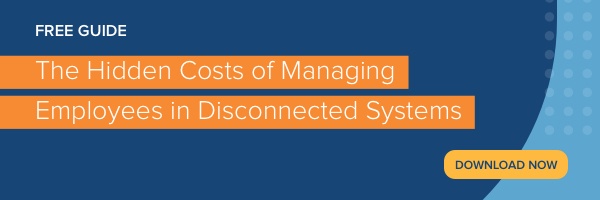Having an accurate count of employee hours enables you to manage what is likely your organization’s largest expense: payroll. Whether you’re managing nursing shifts in a healthcare organization or tracking employee working hours in a retail or manufacturing setting, time and attendance tracking impact the accuracy of your entire payroll function.
Using paper time and attendance records or a system that doesn’t integrate with payroll requires manual inputs and leads to a greater chance for error. Alternatively, when you connect your time-tracking and payroll systems, you not only deliver the correct compensation to employees, but you also access deeper insights about the productivity of your workforce.
What Is a Connected Time-Tracking and Payroll System?
Time tracking and payroll go hand in hand, and the systems you use to manage them should too. By connecting the systems, you automate two related processes, saving both time and money.
A connected time-tracking and payroll system allows you to seamlessly convert employee work time to accurate paychecks. As a result, you avoid underpaying or overpaying for employee work time, and you can also stay in compliance with internal policy and legal requirements for overtime and vacation pay.
Connecting the two systems allows you to track the following time, attendance, and payroll components:
- Employee working hours and shifts
- Employee time and attendance
- Paid and unpaid leaves
- Overtime
- Compensatory time
- Special payments and exceptions
6 Benefits of Connecting Time Tracking and Payroll
Having a system to stay informed about employee hours and absences is essential for effectively managing your workforce. In fact, according to a Deloitte global survey of payroll professionals, time and attendance systems were found to be the number one component of workforce management strategy, with labor scheduling coming in at number two.
Time tracking is one of the most critical ways to manage labor costs and employee productivity. When it is integrated into your payroll system, you can realize the following benefits:
1. Greater Accuracy in Payroll
In an integrated system, working hours, overtime, and absences automatically translate to accurate pay. There are no manual calculations of working hours or days, which can lead to costly errors. With one centralized system, you don’t have to worry about discrepancies between payroll and HR records. When the two are combined under the umbrella of one workforce management system, information about employee time, attendance, and pay is reflected accurately throughout the platform.
2. Less Paperwork
When payroll is integrated with HR activities for tracking time, leaves, and schedules, you don’t have to maintain separate sets of files or documents for each. You can eliminate the paper and keep all of your workforce data in one system.
3. Consolidated Reporting
With connected time-tracking and payroll systems, you benefit from integrated reporting. You can generate real-time reports detailing when employees are working, where, and according to which schedules. Moreover, comprehensive reporting capabilities allow you to compare hours and overtime within and between departments and functions.
4. Better Compliance
A system that aligns employee time and attendance with payroll allows you to stay in compliance with federal and state labor laws, such as the Fair Labor Standards Act (FLSA) overtime rule and the Affordable Care Act (ACA). With better compliance, you are also taking steps to avoid regulatory fines and wage and hour lawsuits.
5. An Improved Employee Experience
Having a connected system to accurately track time and pay helps you meet employee expectations for timely, error-free paychecks. When employees are spared the frustration that comes with an incorrect paycheck, they have a chance to build trust and engagement at work. Additionally, an integrated system includes self-service features that keep employees informed about their pay and give them access to forms and other resources.
6. Better Management of Labor Costs
With accurate time, attendance, and payroll data, it’s easier to identify employee hours and attendance trends, such as instances when employees are working more overtime or taking less time off. With this data, you have greater visibility into labor costs, and you can track your payroll expenses against your budget with greater ease.
Features to Look for in an Integrated System
Connecting your time-tracking and payroll systems doesn’t require any heavy lifting on your part. It just requires selecting a system with the capabilities to help you realize all of the core benefits of an integrated system. Look for the following features when evaluating your options:
- Cloud-based, 24/7 access
- Reporting and dashboards to help you analyze workforce data and identify trends
- Tools for maintaining compliance with federal and state labor laws
- Employee self-service
- The ability to configure employee schedules and shifts to match your operating schedule
- Alerts and reminders to help you stay on top of pay periods, deadlines, and time-off requests
Improve Workforce Management with an Integrated Platform
On any given day, a lot is going on within your workforce. A mix of new hires, scheduling changes, pay adjustments, and transfers requires the technology to keep track of it all. Instead of managing the workforce with a myriad of HR and payroll systems that each have different operating protocols and reporting, select an integrated system and keep everything on one easy-to-use platform.
An all-in-one workforce management system enables you to measure employee time and attendance, while also managing benefits, payroll, and recruiting activities. For more insights to help you improve your workforce management capability, download our e-book, The Hidden Costs of Managing Employees in Disconnected Systems.


